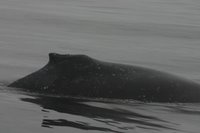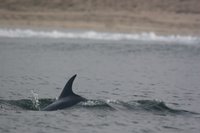A belated report from Day 3 by David:

Sometimes a little engine trouble’s not a bad thing. When both the Astirix and the Spy Hop were giving Sean fits but no starts, Peter decided that he, Eugene, Larry and I would used our allotted dolphin time instead to continue our previous day’s work on Otter Patrol – but this time in kayaks, in Elkhorn Slough. According to some, the Slough (rhymes with through – not with rough or bough), which – speaking loosely – is a tidal estuary, takes its name from its meandering, antlerish shape. (That’s my favorite of the explanations. Others cite an elkhorn plant found there and the one-time presence of a lodge for elk hunters.) About 7 miles long, it’s technically an extended inlet or fjord, rather than an estuary; for most of the year, it’s entirely salt water, with fresh-water run-off entering only for brief periods, if at all.
Neither Eugene nor Larry had ever been in a kayak, but were game to go. (I particularly enjoyed watching Larry’s eyebrows crawl toward his hairline as he learned that self-rescue from an overturned kayak means detaching the spray skirt and

extricating oneself from the cockpit while upside down underwater.) They took a tandem, the theory being that two novice paddlers are better than one. Peter and I were in solo boats.
Once lunches and gear were stowed, we got under way, drifting with the incoming tide from Moss Landing Harbor, past lounging otters and the pile-driving crew installing a new jetty, under Highway One, and finally into the quiet of the Slough. In people terms we had it almost to ourselves. In our four or so hours there, we saw only three other kayakers. But in wildlife

terms, we were surrounded in three dimensions, by scattered otters foraging and playing, harbor seals surfacing long enough to give us the eye, the odd sea lion, egrets both snowy and great, curlews and godwits, assorted herons, a variety of gulls and terns, and pelicans both overhead and in congregations of hundreds lining the banks in some mid-day ritual of dozing, yawning and pecking at the noisy gulls that dared to light among them.
Peter had hoped that we could find a way to orchestrate data-taking from the boats, but the tidal push of incoming and the pull of outgoing made it too difficult to focus on any particular otter or otters without resorting to paddling, which would be both disturbing to the otters and a risk to dry data sheets. We never resolved the problem, but came up with several ideas ranging from ‘possible’ to ludicrously impractical. The jury is still out on long periods of observation from kayaks in tidal water.
We ended the trip by paddling out of the Slough and into the marina, to sample the mind-numbing sight of seals, sea lions,

otters, and pelicans resting and feeding in the oil-shiny, gas-reeking water. How they survive – how they tolerate it – I can’t imagine.
In short, perhaps not a productive research foray in the Slough, but – for the volunteers – an excellent introduction to one of the Bay’s most significant ecological features.
The day’s cake also had two layers of icing. On our return, we learned that Sean had the Spy Hop running well enough to make a test run out into the Bay itself, and he invited us to go along. Only a few minutes out, cruising at about 20 knots, we picked up an escort of dolphins, who swam alongside and went bow-riding only a few feet beneath our eyes. It was the volunteers’ first exposure to these extraordinary animals – and to the feeling of privilege that accompanies the sense of being welcomed to their world.
Then, that night, Peter (who also took the pictures accompanying this entry – and a hundred more I wish I could include here) gave a presentation for the volunteers on marine mammals – an hour remarkably packed with information on the cetaceans, pinnipeds and carnivores that are the focus of our attention here. The wealth of information, coupled with a scientist’s passion, made for an inspiring talk.
A great day – both on the water and in the classroom.
 Halloween Day by Anna:
Halloween Day by Anna:
















































